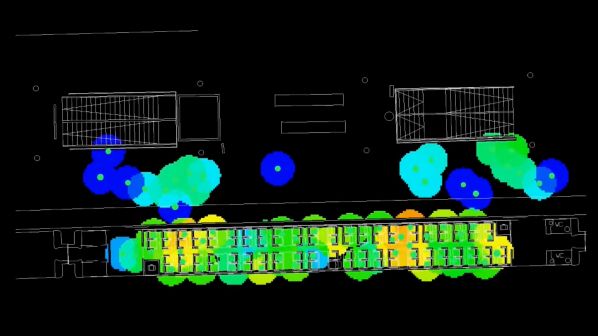An Azuma class 800 coaches used by the operator is the basis for the simulation, which models the movement of passengers through stations, on trains and when alighting or boarding, to understand the number of times two passengers are within a given distance of one another and for how long.
Currently, the simulation models a simple train journey in which 44 initial passengers travel for 30 minutes before 22 alight and 22 more board, before travelling a further 30 minutes before all passengers alight. It models the risk of infection when no mitigating factors such as masks, HVAC or surface cleaning processes are included, according to the current 0.05% estimated infection rate for England from the Office of National Statistics (ONS).
According to the current model, the current rate of infection is around 1 in 11,000 journeys. RSSB has confirmed that work on quantifying these mitigations and the impact of different social distancing measures used in estimating infection risk per passenger contact has been shared with LNER.
LNER is using the results from the analysis to support their risk assessments for seating plans and reservations, with the view of maximising its service capacity within safe limits. The analysis will also be used in review discussions with the Office of Rail and Road (ORR), Britain’s independent transport regulator.
“I’m really pleased we could work with RSSB to deliver this work and share results with other rail operators,” says Mr Iain Ferguson, head of safety and sustainability at LNER. “The work we did shows that onboard, customers and staff can be assured that they are as safe as can be in any other indoor environment. Together we were able to be assured that LNER is taking the right measures to control risk, by taking advantage of the data made available to us through the crowd simulation work.”
Work is now underway to incorporate estimates for the effectiveness of mitigation processes in reducing the risk of infection, which will be incorporated into future simulations. In addition, RSSB is looking to develop more complex models using different train types, more complex journeys and various loading scenarios. It says this will help to target the infection rate per journey to particular operators, regions, or even individual train services.
In the longer term, RSSB also plans to include different station layouts for a better understanding of passenger movements across entire British rail network.
The models are intended to enable the British rail industry to better understand and mitigate the transmission of Covid-19, support decision-making and encourage passengers to return to rail. It is hoped that the data will help support the recovery of the British rail industry after the pandemic.
Britain is currently registering 938 lab-confirmed cases of coronavirus per day and has reported 305,623 total Covid-19 cases so far. Since the start of the pandemic, passenger numbers on the rail network has fallen as low as 4% for some operators.
The methods, assumptions and values used in the simulation were presented for verification to the Department for Transport’s chief scientific officer on July 31.

